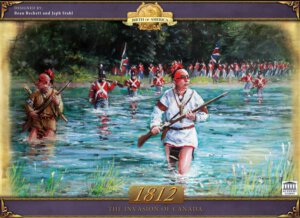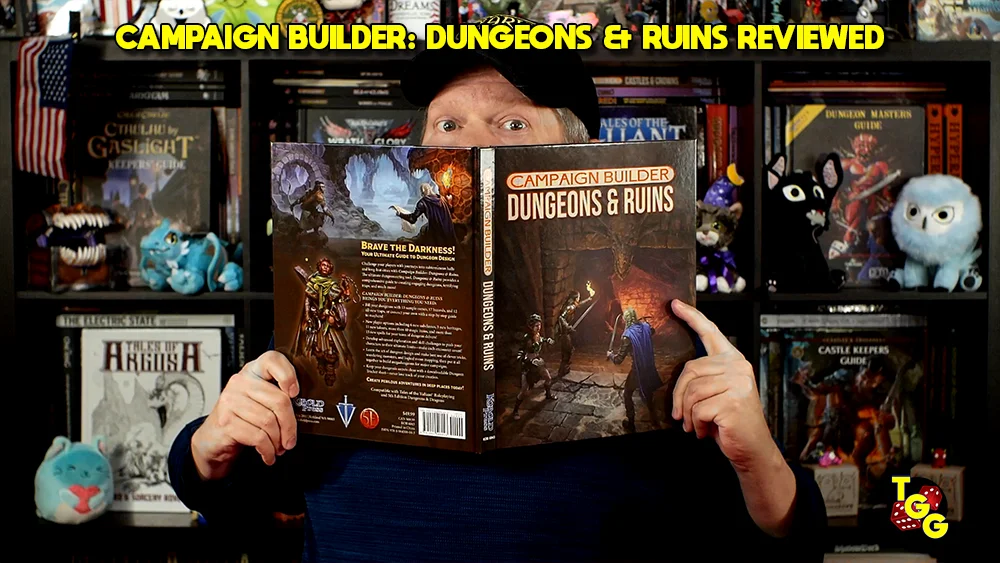
Publisher: Academy Games
Designers: Beau Beckett and Jeph Stahl
Artists: Jarek Nocoń and Steve Paschal
Year: 2012
Genre: Semi-abstract area control wargame of the War of 1812
Players: Two to five players
Ages: 10+
Playing Time: 60-90 minutes
MSRP: $65.00
In life we find you can’t always judge a book by its cover and 1812: The Invasion of Canada certainly fits that mantra. This was the first time I’d had a chance to sit down with a title from Academy Games (no, I’ve not yet to have the opportunity to play any of the Conflict of Heroes line) but I had seen many of their titles up close at last year’s Origins and they looked mighty impressive. Well defined and rendered counters along with beautiful maps looked to be the order of the day at Academy. That’s why I scratched my head a bit when I say the promotional materials for 1812 and saw… little wooden cubes? When I received the game and opened the box I scratched my head a little bit. This is from the same people who do Conflict of Heroes and Strike of the Eagle? Hmmm…
Then I got to play the game and have to say wow! This is a pretty exciting first entry into Academy Games’ Birth of America series!
I’ll just jump back a bit an make sure that everyone understands that I’m not implying the components aren’t top notch, because they are, but I was just surprised by what seems as a complete 180 from what people may expect from Academy Games. All the components included are of excellent quality all in all.
Obviously, it is the War of 1812 – a conflict sorely underrepresented in the gaming world – and the Americans declared war for several reasons, including trade restrictions due to Britain’s ongoing war with France, the impressment of American merchant sailors into the Royal Navy, British support of American Indian tribes against American expansion, and outrage over insults to national honor after humiliations on the high seas. I’ll be honest here and say mainly America was looking for excuses to take advantage of Britain being tied up in their war with Napoleon in order to gobble up more territory.

Each faction possesses a specific set of color coded dice and twelve unique action cards. If you play the full campaign, each faction will have the full dozen cards at their disposal. Shorter campaigns will state what cards each faction receives. Each turn players will have a hand of three cards and once a card is played it is gone – as in forever as it can never be played again that game. On each player’s turn they must play a movement card and if they only have special cards in their hand they may show their hand and place those cards back into their deck, reshuffle, and draw three new cards. This is the only time a deck will be reshuffled once the game starts.

Each turn has a random play order as each faction has a turn order cube that goes into a bag and is randomly drawn.
The turn breaks down as follows:
Draw Turn Order Marker -This determines the first player although in the campaign game the American Regulars are automatically the first player in the first turn.
Play Enlistments and Fled Units – The player whose turn it is will place their new enlistment cubes in their muster areas; each faction has one or two muster areas and the Native Americans actually can place an enlistment cube in their own muster area one in any other area containing one of their units. Next are the Fled Units. These are cubes that fled a battle and they can be added back into a muster area. If there are no longer any units available of the faction color no cubes are placed and if the muster areas are controlled by the enemy you may not place either Enlistments or Fled units either. If this happens those Enlistments are lost for the turn and the Fled Units are left in the Fled Units space.
Play a Movement Card and up to two Special cards – Each faction has eight Movement and four Special cards in their deck. You must play a movement card on your turn as mentioned previously. All cubes in an area are considered to be an army regardless of what factions make up that force. In order to move an army, the active player must control at least one of the cubes in that area. The movement card played will show how many armies may be used and the number of areas that may be moved by each army. Some cards will allow for water movement as well.

Next, the side without initiative will roll their dice and apply the results. The sides continue rolling dice until only one side remains and they take the field.
The main object of the game is to control the opposing side’s objectives so the battles around these areas will be hot and heavy!
Draw Cards – Finally, the active player will draw up to the hand limit of three cards.
Now the next Turn order cube is drawn from the bag and that player repeats the above process.

The game comes to an end when the Treaty of Ghent is signed, which is really controlled by the players. There is no set number of turns because of those Treaty cards I mentioned earlier. When one side has played all of their Truce cards the war comes to an end and the side that controls the most of their opponent’s objectives is the winner. The game can end in a tie but such are the fortunes of war. Even the full campaign with all five players should be completed in around an hour and a half.
1812: The Invasion of Canada is an extremely tight design and the rules can be taught in no more than five minutes or so. There’s almost no downtime and the players are constantly engaged; if they aren’t rolling dice in battles they’re involved in then they’re discussing, with their allies, strategies and options since the active player has control over armies that are usually made up of various factions. I’ve found there’s plenty of smack talking and busting on even your allies when they botch a die roll or blunder into an untenable situation.
The only negative I can think of, and it’s not really a negative, is the diehard grognard crowd may find the game to be a bit too abstract and streamlined for their tastes. Although, I will say, they may be surprised by how much meat is actually under the hood of 1812.
1812: The Invasion of Canada is going to generate a lot of buzz and I’ll say right here and now that it will certainly be an entry on many historical game of the year award ballots!
[rwp-review id=”0″]
- The Old Margreve for Tales of the Valiant Reviewed - Apr 27, 2025
- Marvel Comics for April 30th, 2025 - Apr 27, 2025
- DC Comics for April 30th, 2025 - Apr 27, 2025



















Played my first game with 4 other newbies and liked it enough to order two copies . . . Even though we Americans got thoroughly whacked – 9 point diff!
This game can be summed up simply with a big “GREAT”. It can be played by every level of gamer with satisfaction for all. It is not uncommon for our group of gamers to play this game over and over in one evening. The look and feel is impressive and gameplay is a dream come true. Kudos to everyone involved in the gift of this game! Well done Academy Games! You have earned our continuing patronage.